Canon POWERSHOT S3 Manual
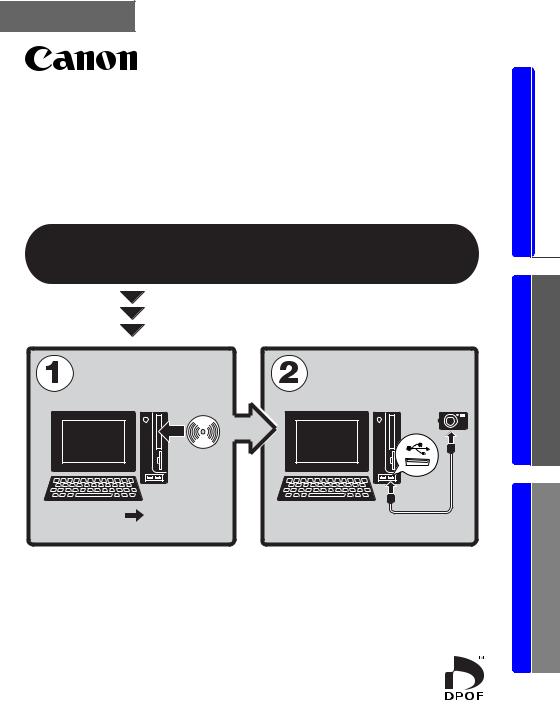
ENGLISH
Software Starter Guide
(For the Canon Digital Camera Solution Disk Version 28)
You must install the software bundled on the Canon Digital Camera Solution Disk before connecting the camera to the computer.
Install the |
Connect the camera |
software. |
to the computer. |
Windows |
p. 11 |
Macintosh  p. 44
p. 44
•This guide explains how to install the software programs and briefly introduces their functions and operating procedures.
•Please read the software license agreement that displays during installation before using the software on the supplied CD-ROM. You must accept the terms and conditions of the software license agreement to use the software.
 Windows/Macintosh
Windows/Macintosh
Windows
Macintosh
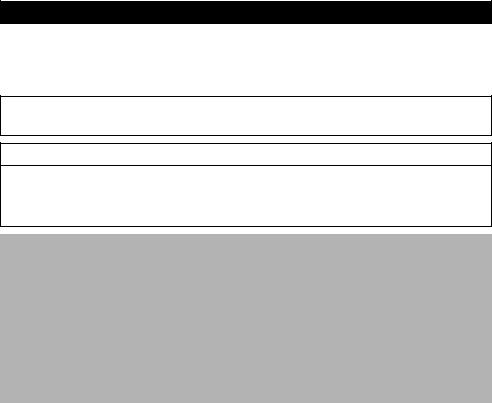
SAFETY PRECAUTIONS
The precautions noted within this guide are intended to instruct you in the safe and correct use of the products and to prevent injuries or damage to yourself, other persons and property. Please read and ensure that you understand them before proceeding to other sections of the guide.
 Warnings This symbol indicates topics that could lead to death or serious injury if ignored or handled incorrectly.
Warnings This symbol indicates topics that could lead to death or serious injury if ignored or handled incorrectly.
 Warnings
Warnings
•Do not play the supplied CD-ROM(s) in any CD player that does not support data CD-ROMs. Playing the CD-ROM(s) in an audio CD player (music player) could damage the speakers. It is also possible to suffer from hearing loss from listening with headphones to the loud sounds of a CD-ROM played on a music CD player.
Disclaimer
•While every effort has been made to ensure that the information contained in this guide is accurate and complete, no liability can be accepted for any errors or omissions. Canon reserves the right to change the specifications of the hardware and software described herein at any time without prior notice.
•No part of this guide may be reproduced, transmitted, transcribed, stored in a retrieval system, or translated into any language in any form, by any means, without the prior written permission of Canon.
•Canon makes no warranties for damages resulting from corrupted or lost data due to a mistaken operation or malfunction of the camera, the software, the CompactFlash™ cards (CF cards), personal computers, peripheral devices, or use of non-Canon CF cards.
Trademark Acknowledgments
•ArcSoft, the ArcSoft logo and ArcSoft PhotoStudio are trademarks or registered trademarks of ArcSoft, Inc.
•Adobe is a trademark of Adobe Systems Incorporated.
•CompactFlash is a trademark of SanDisk Corporation.
•Macintosh, Mac OS and QuickTime are trademarks of Apple Computer Inc., registered in the United States and other countries.
•Microsoft® and Windows® are either registered trademarks or trademarks of Microsoft Corporation in the United States and/or other countries.
•Other names and products not mentioned above may be registered trademarks or trademarks of their respective companies.
Copyright © 2006 Canon Inc. All rights reserved.

1
Table of contents |
|
Read This First |
3 |
It’s so Simple! Make Prints Right at Home Like a Pro ...................... |
4 |
Unbounded Possibilities with Entertaining Software ..................... |
6 |
System Requirements ........................................................................ |
8 |
Programs and Compatible Operating Systems ................................ |
9 |
Before You Connect the Camera to the Computer ....................... |
10 |
Using the Software on the Windows Platform |
|
– Preparations |
11 |
Installing the Software and USB Driver .......................................... |
11 |
Using the Software on the Windows Platform |
|
– The Basics |
16 |
Downloading Images to the Computer .......................................... |
16 |
Printing Images ................................................................................ |
21 |
Using the Software on the Windows Platform |
|
– Advanced Techniques |
24 |
The ZoomBrowser EX Windows ...................................................... |
24 |
ZoomBrowser EX Features .............................................................. |
30 |
Replaying Movies ............................................................................. |
33 |
Editing Movies ................................................................................. |
34 |
Operating the Shutter Remotely .................................................... |
35 |
Merging Panoramic Images - PhotoStitch ...................................... |
38 |
Enjoy Customizing Your Camera with the My Camera Settings ... |
39 |
Using the Software on the Macintosh Platform |
|
– Preparations |
44 |
Installing the Software .................................................................... |
44 |
Using the Software on the Macintosh Platform |
|
– The Basics |
46 |
Downloading Images to the Computer .......................................... |
46 |
Printing Images ................................................................................ |
50 |
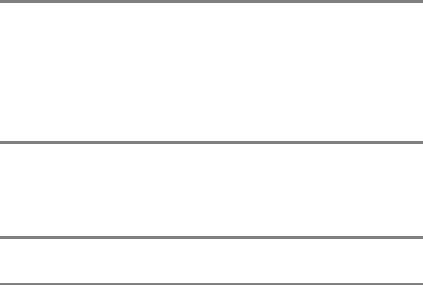
Table of contents |
2 |
|
|
Using the Software on the Macintosh Platform |
|
– Advanced Techniques |
52 |
The ImageBrowser Windows .......................................................... |
52 |
ImageBrowser Features ................................................................... |
58 |
Replaying Movies ............................................................................. |
61 |
Editing Movies ................................................................................. |
62 |
Operating the Shutter Remotely .................................................... |
63 |
Merging Panoramic Images - PhotoStitch ...................................... |
66 |
Enjoy Customizing Your Camera with the My Camera Settings ... |
67 |
Appendices |
72 |
ArcSoft PhotoStudio ........................................................................ |
72 |
Uninstalling the Software ............................................................... |
74 |
Memory Card Folder Structure ....................................................... |
77 |
Troubleshooting .............................................................................. |
78 |
Information about Your Camera |
87 |
Non-Supported Programs and Features ......................................... |
87 |
Index |
88 |

3
Read This First
This chapter explains what you can accomplish using the camera with the software contained on the Canon Digital Camera Solution Disk.
It also lists the computer system configurations required to use the software.
About this Guide
•The explanations in this guide are based on Windows XP and Mac OS X v10.3. If you are using another version of these operating systems, the actual screen contents and procedures may vary slightly from those shown.
•The following terms are used in this guide. Mac OS X is used for Mac OS X (v10.2-v10.4)
Memory card is used for CF cards, SD cards, MultiMediaCards and PC cards.
Method for Downloading to a Computer without Additional Software
Your camera uses a standard image transfer protocol called Picture Transfer Protocol (PTP). With PTP and Windows XP or MaC OS X, you can download images without having to install additional software. However, there are some inconveniences and limitations to this downloading method. See the For Windows® XP and Mac OS X Users leaflet for details.
Windows/Macintosh
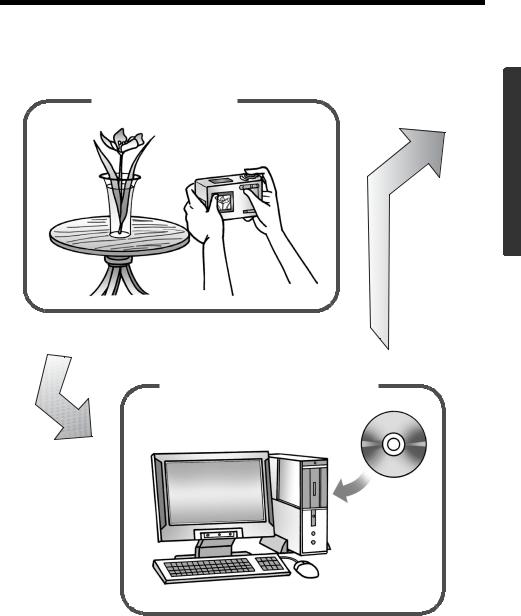
Read This First |
4 |
|
|
It’s so Simple! Make Prints Right at Home Like a Pro
Shoot the images
Windows/Macintosh
See your Camera User Guide for shooting instructions.
Install the software on the computer
Windows (p. 11)
Macintosh (p. 44)
Just install the software once at the beginning.
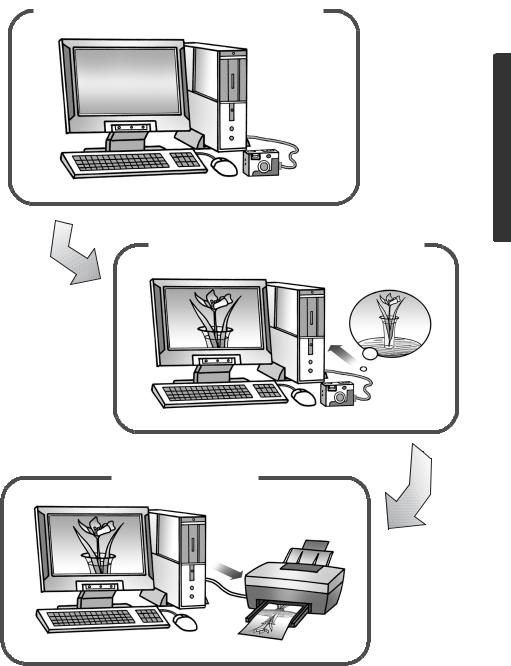
Read This First |
5 |
|
|
Connect the camera to the computer
Precautions for
Connecting the
Camera to the
Computer (p. 10)
See your Camera User Guide for connecting instructions.
Download images to the computer
Windows/Macintosh
Windows (p. 16)
Macintosh (p. 46)
Print the images
Windows (p. 21)
Macintosh (p. 50)
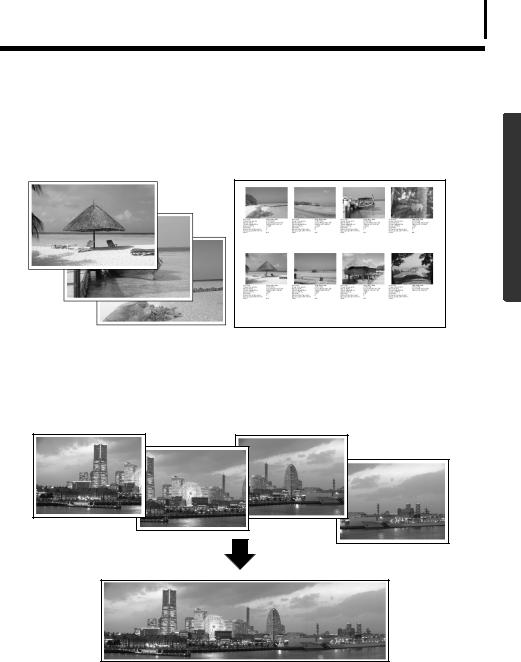
Read This First
Unbounded Possibilities with Entertaining Software
Print a Variety of Layouts
Print with the diverse layouts available in ZoomBrowser EX (Windows) and ImageBrowser (Macintosh). The examples shown are from ZoomBrowser EX (Windows).
With One Photo per Page Print, |
Confirm all your images in one glance |
printing images is also easy. |
with index (contact sheet) printing. |
Stitch a Panorama Together
Create a panoramic image from a series of images with PhotoStitch.
6
Windows/Macintosh
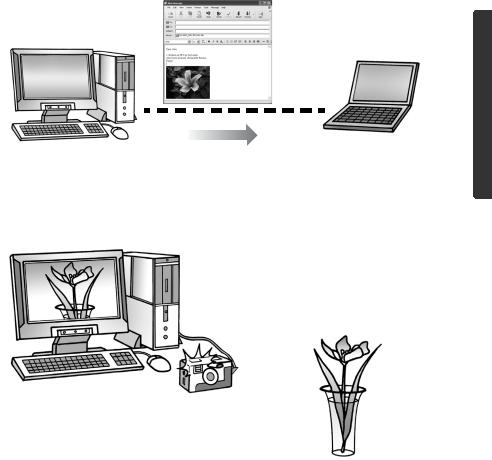
Read This First |
7 |
|
|
Send an Image as an E-mail Attachment
Attach an image to an e-mail message by starting your mail software from within ZoomBrowser EX (Windows) or ImageBrowser (Macintosh).
Windows/Macintosh
Operate the Camera Shutter from the Computer
You can use ZoomBrowser EX (Windows) or ImageBrowser (Macintosh) to operate the camera shutter from the computer to shoot images (Remote Shooting). The recorded images are downloaded directly to the computer.
The shutter is operated from the computer.
Edit a Movie
You can edit movies, linking movies and stills that have been downloaded to the computer, adding text, such as titles, adding background music or applying various special effects.
Extract Stills from Movies
You can extract a still from the displayed movie and save it as a new image file. You can also specify a range of frames and extract multiple stills.

Read This First |
8 |
|
|
System Requirements
Please install the software on a computer meeting the following minimum requirements.
Windows
OS |
ports. |
|
Windows/Macintosh |
Windows 98 Second Edition (SE) |
|
|
|
|
Windows Me |
|
|
|
Windows 2000 Service Pack 4 |
|
|
|
Windows XP (including Service Pack 1 and Service Pack 2) |
|
|
|
|
|
|
Computer Model |
The above OS should be pre-installed on computers with built-in USB |
|
|
|
|
|
|
CPU |
Pentium 500 MHz or higher processor |
|
|
|
|
|
|
RAM |
Windows 98 SE/Windows Me: 128 MB or more |
|
|
|
Windows 2000/Windows XP: 256 MB or more |
|
|
|
|
|
|
Interface |
USB |
|
|
|
|
|
|
Free Hard Disk |
•Canon Utilities |
|
|
Space |
- ZoomBrowser EX: |
200 MB or more |
|
|
- PhotoStitch: |
40 MB or more |
|
|
•Canon Camera TWAIN Driver: |
25 MB or more |
|
|
•Canon Camera WIA Driver: |
25 MB or more |
|
|
•ArcSoft PhotoStudio: |
50 MB or more |
|
|
|
|
|
Display |
1,024 x 768 pixels/High Color (16 bit) or better |
|
|
|
|
|
|
Macintosh |
|
|
|
|
|
|
|
OS |
Mac OS X (v10.2-v10.4) |
|
|
|
|
|
|
Computer Model |
The above OS should be pre-installed on computers with built-in USB |
|
|
|
ports. |
|
|
|
|
|
|
CPU |
PowerPC G3/G4/G5 |
|
|
|
|
|
|
RAM |
256 MB or more |
|
|
|
|
|
|
Interface |
USB |
|
|
|
|
|
|
Free Hard Disk |
•Canon Utilities |
|
|
Space |
- ImageBrowser: |
200 MB or more |
|
|
- PhotoStitch: |
40 MB or more |
|
|
•ArcSoft PhotoStudio: |
50 MB or more |
|
|
|
|
|
Display |
1,024 x 768 pixels/32,000 Colors or better |
|
|
|
|
|
|
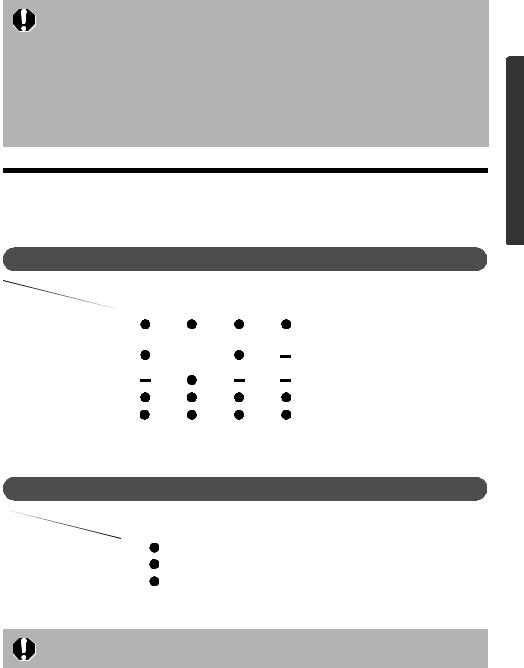
Read This First |
9 |
|
|
•A CD-ROM drive is required to install the software.
•Even when system requirements are met, not all computer functions can be guaranteed.
•A sound card is required to play movie file audio tracks under Windows. •With Windows, QuickTime 6.5 is required to save images merged with PhotoStitch as the QuickTime VR type. It is also required to play and edit
movies on the Windows 98 SE, Windows Me and Windows 2000 platforms. QuickTime is included on the Canon Digital Camera Solution Disk.
•Macintosh software cannot be used on disks formatted in the UFS (Unix File System) format.
Programs and Compatible Operating Systems
The CD-ROM labeled “Canon Digital Camera Solution Disk” is provided with all models. It contains the following programs.
Windows Programs
|
Compatible OS |
Windows |
|
Windows |
Windows |
Windows |
Major Functions |
||
Program |
98 |
|
Me |
2000 |
XP |
||||
|
|
||||||||
|
|
|
|
|
|
|
|
|
|
ZoomBrowser EX |
*3 |
|
|
|
|
|
|
Downloading, displaying, |
|
|
|
|
|
|
|
|
organizing and editing images |
||
|
|
|
|
|
|
|
|
|
|
|
|
|
|
|
|
|
|
|
|
TWAIN Driver |
*3 |
|
|
|
|
|
*4 |
Driver for Canon brand cameras (for |
|
|
|
|
|
|
|
|
Windows 98, Windows 2000) |
||
|
|
|
|
|
|
|
|
|
|
|
|
|
|
|
|
|
|
|
|
WIA Driver |
|
|
|
|
|
|
*4 |
Driver (Windows Me) |
|
|
|
|
|
|
|
|
|
|
|
PhotoStitch*1 |
*3 |
|
|
|
|
|
|
Merging images to make panoramas |
|
ArcSoft PhotoStudio*1 *2 |
|
|
|
|
|
|
|
Advanced image editing |
|
*1 |
Can be started from within ZoomBrowser EX. |
|
|
|
|||||
*2 |
Image editing program manufactured by ArcSoft, Inc. |
|
|
||||||
*3 |
Compatible with Windows 98 SE only. |
|
|
|
|
|
|
||
*4 |
Driver not required because Windows XP supports PTP. |
|
|
||||||
Macintosh Programs
|
Compatible OS |
Mac OS X |
Major Functions |
Program |
|
|
|
ImageBrowser |
|
Downloading, displaying, organizing and editing images |
|
|
|
|
|
PhotoStitch*1 |
|
Merging images to make panoramas |
|
ArcSoft PhotoStudio*1 *2 |
|
Advanced image editing |
|
*1 |
Can be started from within ImageBrowser. |
|
|
*2 |
Image editing program manufactured by ArcSoft, Inc. |
||
Windows/Macintosh
See ArcSoft PhotoStudio (p. 72) for information about this program.

Read This First |
10 |
|
|
Before You Connect the Camera to the Computer
Ensure that you have installed the software from the supplied Canon Digital Camera Solution Disk before you connect the camera to the computer.
Precautions for Connecting the Camera to the Computer
•The connection may not operate correctly if you attach the camera to the computer with an interface cable via a USB hub.
•The connection may not operate correctly if you are using other USB devices, excluding USB mice or keyboards, at the same time as the camera. If this occurs, disconnect the other devices from the computer and try reconnecting the camera.
•Do not connect two or more cameras at the same time to the same computer. The connections may not operate correctly.
•Never allow the computer to go into standby (sleep) mode while a camera is connected via the USB interface cable. If it does happen, never disconnect the interface cable. Try to awaken the computer with the camera in the connected state. Some computers will not awaken properly if you disconnect the camera while they are in standby (sleep) mode. Please refer to your computer manual for instructions regarding the standby (sleep) mode.
•You are recommended to power the camera from a household power source (AC adapter) when connecting to a computer (if available for your camera model). Ensure that you use fully charged batteries if you will not be using a household power source.
•See the Camera User Guide for procedures connecting the camera to the computer.
Windows/Macintosh
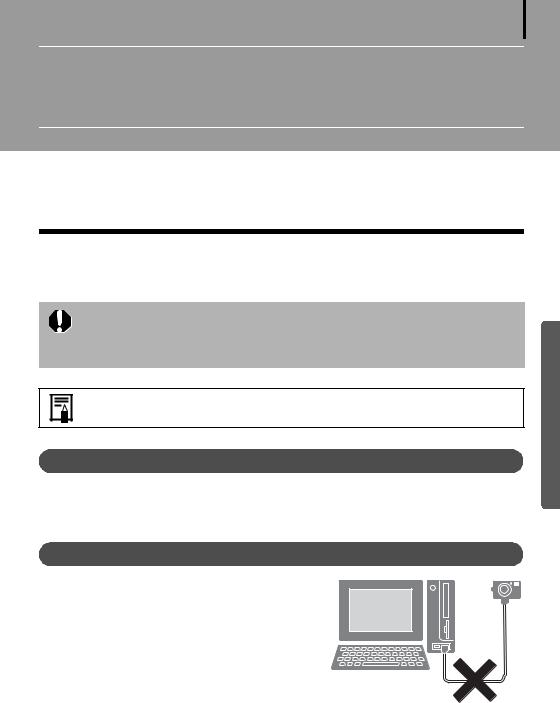
11
Using the Software on the Windows Platform – Preparations
This chapter explains the basic procedures for installing the software and connecting the camera to a computer. Read this material before you connect the camera to the computer.
Installing the Software and USB Driver
Start by installing the software from the Canon Digital Camera Solution Disk.
•You must install the software before you connect the camera to the computer.
•Users of Windows XP and Windows 2000 must first log in as an Administrator (computer system administrator) to install programs.
See ArcSoft PhotoStudio (p. 72) for details on how to install ArcSoft PhotoStudio.
Items to Prepare
•Your camera and computer •Canon Digital Camera Solution Disk
•Interface cable supplied with the camera
Installation Procedures
1 Confirm that the camera is NOT connected to the computer.
If it is, disconnect the cable. The software cannot be properly installed if the camera is connected to the computer at the start.
2 Close any programs that are running.
Windows
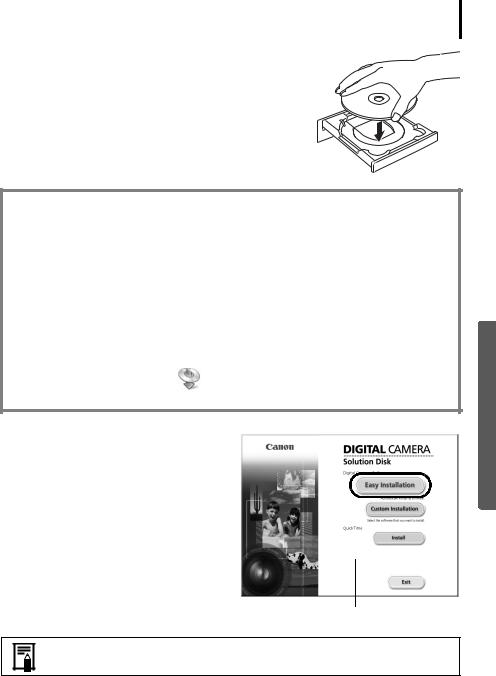
Using the Software on the Windows Platform – Preparations |
12 |
3 Place the Canon Digital Camera Solution Disk in the computer’s CD-ROM drive.
If the installer panel does not appear automatically, use the following procedures.
How to Display the Installer Panel
Use the following procedures to display the installer panel if it does not appear automatically.
Windows XP
1.Select [My Computer] from the [Start] menu.
2.Right-click the CD-ROM icon and select [Open].
3.Double-click the [SETUP.EXE]  icon.
icon.
Windows 2000, Windows Me, Windows 98 SE
1.Double-click the [My Computer] icon on the desktop.
2.Right-click the CD-ROM icon and select [Open].
3.Double-click the [SETUP.EXE] icon.
Some computers may not display the [.EXE] file name extension as shown above.
4 Click the Digital Camera Software [Easy Installation] button.
To individually select the software to install, click [Custom Installation].
Windows
Installer Panel
Follow any instructions to restart your computer, if they appear. If the following window appears, continue with the installation.
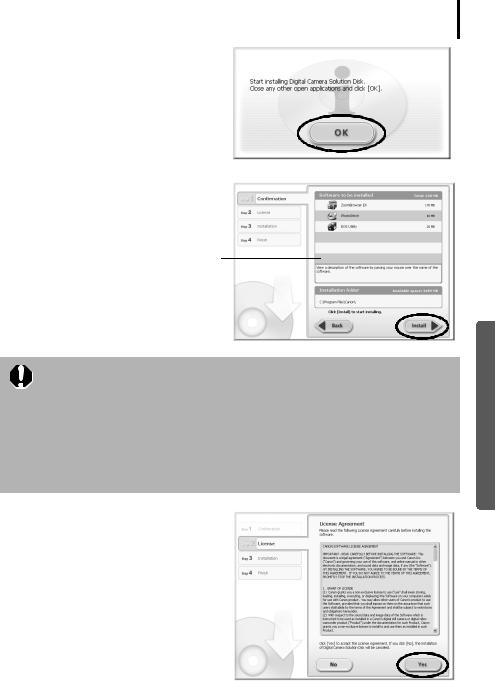
Using the Software on the Windows Platform – Preparations |
13 |
5 If other software is running, close each program before clicking [OK].
6 Review the installation settings and click [Install].
The items displayed here differ according to the software installed.
When [Custom Installation] is Selected
The USB driver (the software for connecting) is required when the camera is connected to the computer with an interface cable. Ensure that you select a USB driver from below (the appropriate one for your operating system).
•Windows 2000/Windows 98 SE: Canon Camera TWAIN Driver •Windows Me: Canon Camera WIA Driver
With Windows XP, the USB driver supplied with the Windows operating system is used so there is no need to install a USB driver.
7 Click [Yes] if you agree to all of the terms of the software license agreement.
The installation will start.
Follow the onscreen instructions to proceed.
Windows
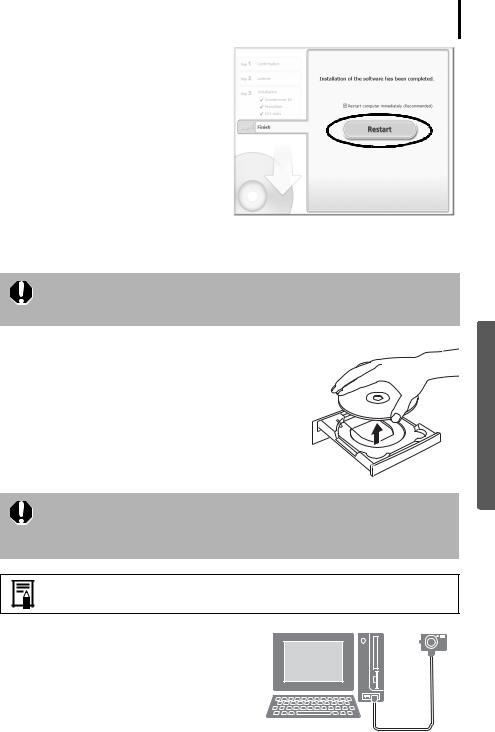
Using the Software on the Windows Platform – Preparations
8 When the installation is over, select [Restart computer immediately (Recommended)] and click [Restart].
At this stage, do NOT remove the Solution
Disk from the CD-ROM drive yet.
If there is no need to restart the computer, the [Finish] screen will display. Click [Finish], remove the Solution Disk from the CD-ROM drive and proceed to Step 10.
Users of Windows XP and Windows 2000 must log in as an Administrator (computer system administrator) after restarting to carry out the subsequent procedures.
9 Remove the disk from the CD-ROM drive when your normal desktop screen appears after restarting.
This concludes the software installation.
Continue by connecting the camera to the computer so that the USB driver can be utilized.
If you installed a USB driver, so far the required files have only been copied to your computer. You must now connect the camera to the computer with the interface cable to complete the installation and prepare the driver for use.
See Uninstalling the Software (p. 74) to delete the installed programs.
10 Attach the camera to the computer with the interface cable and set the camera to the correct mode for connecting.
14
Windows
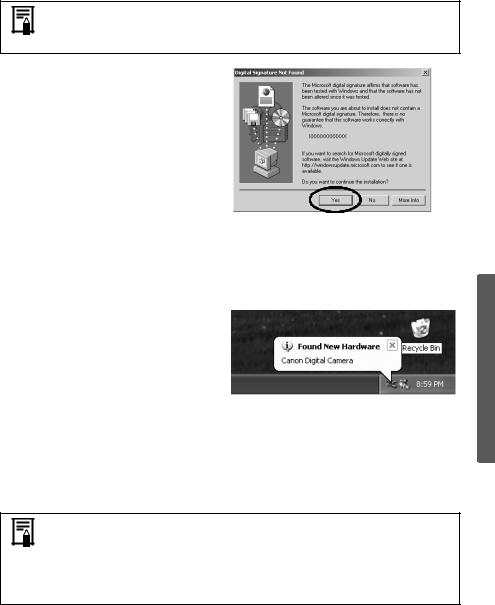
Using the Software on the Windows Platform – Preparations |
15 |
|
|
Procedures for attaching the camera to the computer and placing the camera in the correct mode for connecting vary between camera models. See the Camera User Guide.
If the Digital Signature Not Found window appears, click [Yes].
The USB driver will automatically finish installing onto the computer when you attach the camera and open a connection.
Dialogs similar to the following will appear during this process (first time the camera is connected to a computer only).
Windows XP
The dialog on the right will appear after a few moments.
Windows
Windows 2000/Windows Me/Windows 98 SE
Restart the computer according to the instructions if you are prompted to do so by a message.
A dialog allowing you to set the default settings will display after installation. See Using the Software on the Windows Platform – The Basics (p. 16) for the subsequent procedures.
•See USB driver installation not proceeding well in the Troubleshooting section (p. 78) if you are having problems installing the USB driver.
•See Uninstalling the USB Driver (p. 75) to delete the USB driver installed with these procedures.
•See If You Were Using ZoomBrowser EX Version 2 or 3 (p. 85) if you were previously using either version.
This concludes the software and USB driver installation and the procedures for connecting the camera to the computer.
You may now download camera images to the computer (p. 16).
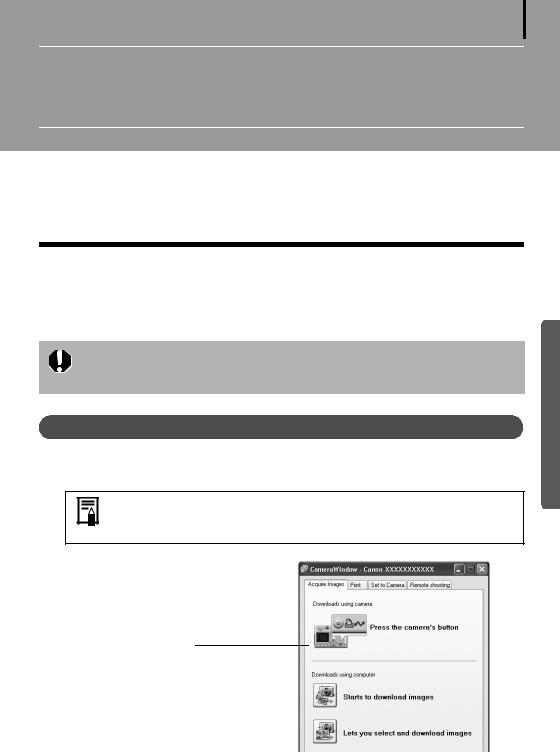
16
Using the Software on the Windows Platform – The Basics
This chapter explains the procedures for using ZoomBrowser EX to download the camera's images to the computer and print them.
Read this chapter after completing the preparations in the Using the Software on the Windows Platform – Preparations section.
Downloading Images to the Computer
Begin by downloading the images to your computer. The downloading procedure is slightly different according to whether you are using a camera to computer connection (see below) or a memory card reader (p. 19).
You may not be able to download images when the camera is connected to a computer if there are a large number of images (approximately 1000) on the memory card. Use a memory card reader to download in that case.
Camera to Computer Connection
1 Attach the supplied interface cable to the computer’s USB port and the camera’s DIGITAL Terminal. Prepare the camera for communication with the computer.
Procedures for attaching the camera to the computer and placing it in the correct mode for connecting vary between camera models. See the
Camera User Guide.
The Camera Control Window will appear.
Windows
Camera Control Window
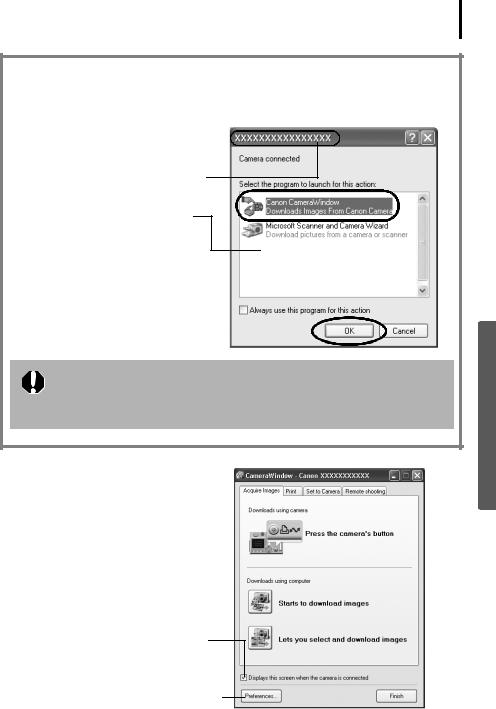
Using the Software on the Windows Platform – The Basics
First Time Camera is Connected to a Computer
Set the following settings the first time you connect the camera to the computer. These procedures are not required from the second connection onward.
Select [Canon CameraWindow] when a dialog (Events dialog) similar to that on the right displays and click [OK].
Your camera model name or [Canon
Camera] will appear here.
Different programs may display according to your computer setup.
If this Events dialog does not appear, click the [Start] menu and select [All Programs] or [Programs], followed by [Canon Utilities], [CameraWindow], [PowerShot - IXY - IXUS - DV 6] and [CameraWindow].
2 Download the images.
Download the images using the camera or the computer. By default, the downloaded images are saved into the [My Pictures] folder.
Placing a check mark here causes this window to automatically open when the camera and computer are connected.
You can adjust the settings, such as the type of image downloaded and the destination folder, by clicking [Preferences].
17
Windows
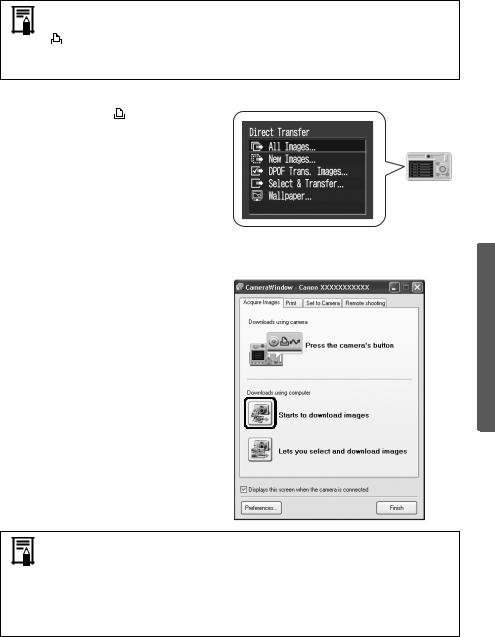
Using the Software on the Windows Platform – The Basics |
18 |
|
|
Using the Camera to Download Images (Direct Transfer Function)
•If the conditions are right for the Direct Transfer function, the Direct Transfer settings menu will appear in the LCD monitor. In addition, the
 (Print/Share) button will light if your camera is equipped with one. •See the Camera User Guide for instructions regarding Direct Transfer
(Print/Share) button will light if your camera is equipped with one. •See the Camera User Guide for instructions regarding Direct Transfer
settings and procedures.
Set the Direct Transfer settings on the camera and press the  (Print/Share) button or the SET button.
(Print/Share) button or the SET button.
Using the Computer to Download Images
Click [Starts to download images].
Windows
•By default, all the images that have yet to be downloaded will download. •To download images that have had their transfer settings set with the camera, click [Preferences] and select [Images whose transfer settings were specified with the camera] as the image type to be downloaded. •Click [Lets you select and download images] to show the camera images
in a list, check the images before downloading and download only selected images.
The downloaded images will be saved into folders according to their shooting date.
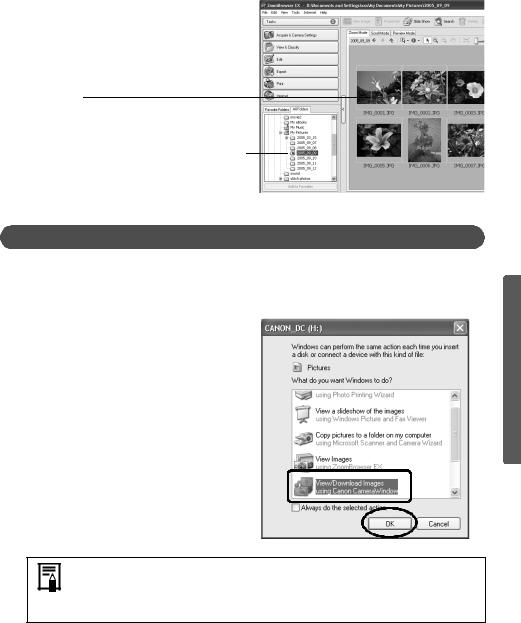
Using the Software on the Windows Platform – The Basics |
19 |
|
|
By default, when downloading is complete, the thumbnails (tiny versions) of the downloaded images display in ZoomBrowser EX’s Main Window.
Thumbnail
The downloaded symbol displays on downloaded folders (the symbol will disappear when you exit ZoomBrowser EX).
Next, print out the images (p. 21).
Memory Card Reader Connection
1 Insert the memory card into the reader.
Use a separately sold card adapter if required.
See the manual for the memory card reader for its connection and handling instructions.
2 Select [View/Download Images using Canon CameraWindow] when the dialog to the right appears and click [OK].
The Camera Control Window will display.
Windows
If the dialog above fails to appear, click the [Start] menu and select [All Programs] or [Programs], followed by [Canon Utilities], [CameraWindow], [PowerShot - IXY - IXUS - DV 6] and [CameraWindow], and proceed to Step 3.

Using the Software on the Windows Platform – The Basics |
20 |
3 Click [Starts to download images].
You can adjust the settings, such as the type of image downloaded and the destination folder, by clicking [Preferences].
•By default, all the images that have yet to be downloaded will download to the [My Pictures] folder.
•To download images that have had their transfer settings set with the camera, click [Preferences] and select [Images whose transfer settings were specified with the camera] as the image type to be downloaded.
•Click [Lets you select and download images] to show the memory card images in a list, check the images before downloading and download only selected images.
•See Memory Card Folder Structure (p. 77) for information about memory card folder structures and file names.
The downloaded images are saved into folders according to the shooting date.
By default, when the download is complete, the thumbnails (tiny versions) of the downloaded images display in ZoomBrowser EX’s main window.
Next, print out the images (p. 21).
Windows
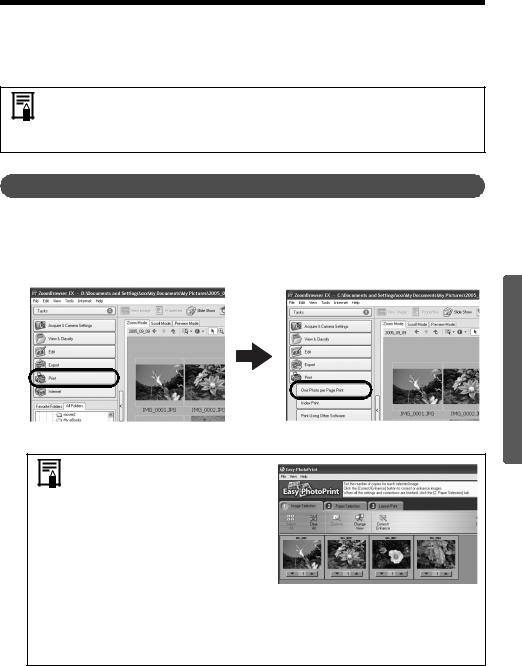
Using the Software on the Windows Platform – The Basics |
21 |
|
|
Printing Images
There are two ways in which images may be printed: One Photo per Page Print and Index Print. This section explains the One Photo per Page Print method.
•Movies cannot be printed, but you can print stills after they have been extracted from movies and saved to files.
•To use the Index Print option, click [Print] in the Main Window, followed by [Index Print].
One Photo per Page Print
This option prints one image per page in a standard "photo" format. If you select multiple images, it will print them on the corresponding number of pages.
1 Click [Print] in ZoomBrowser EX's Main Window, followed by [One Photo Per Page Print].
Windows
•If you have installed the EasyPhotoPrint program that accompanied a Canon-brand printer, you will proceed to the Easy-PhotoPrint printing window shown at the right when you select [One Photo per Page Print] according to the default settings. If a window similar to it opens, read the Help menu for Easy-
PhotoPrint for instructions to proceed.
•To proceed to the ZoomBrowser EX printing window as shown in Step 2 when you select [One Photo per Page Print], click the [Tools] menu and select [Preferences], followed by the [Printing] tab. Select [Use the Print Function in ZoomBrowser EX].
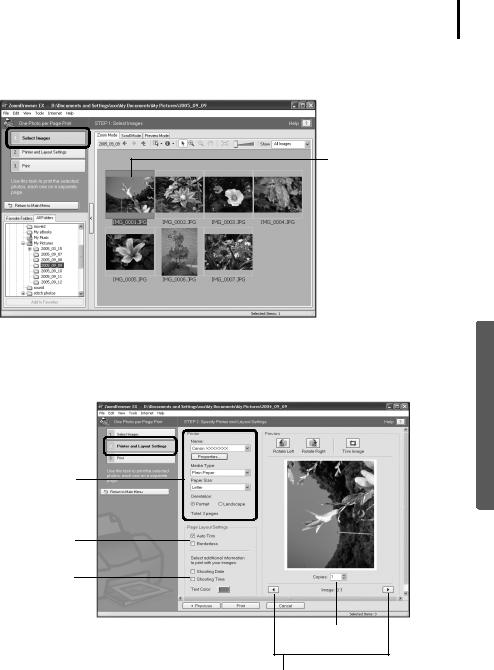
Using the Software on the Windows Platform – The Basics |
22 |
2 After confirming that [1. Select Images] is selected, select images.
You can select multiple images by holding the [Ctrl] down while clicking on successive images.
The background of selected images changes to blue.
3 Click [2. Printer and Layout Settings] and adjust the categories as you feel necessary.
Windows
Selects the printer and the paper size etc.
Sets printing to "borderless," etc.
Place a check mark here to print shooting date/time information with
images.
Sets the number of print copies
This button switches between images if multiple images were selected.
4 Click [3. Print].
Printing will start.

Using the Software on the Windows Platform – The Basics |
23 |
|
|
This chapter explained the ZoomBrowser EX basics. Once you have mastered them, try the advanced techniques.
Using the Software on the Windows Platform – Advanced Techniques (p. 24).
Windows
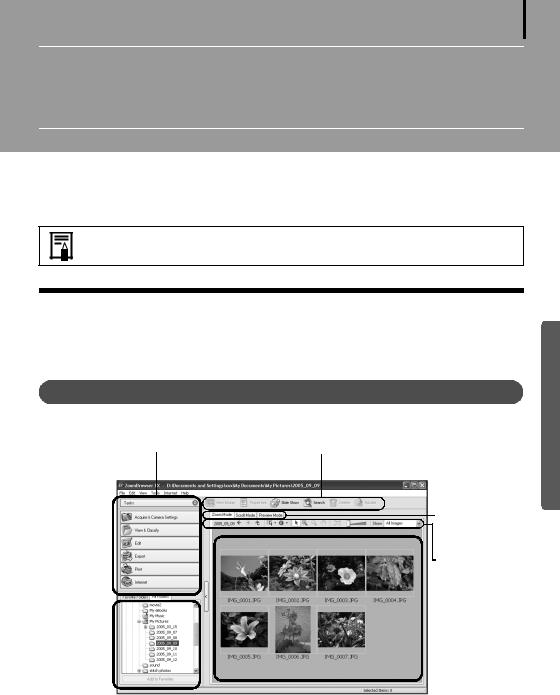
24
Using the Software on the Windows Platform – Advanced Techniques
This chapter explains various ZoomBrowser EX features.
Proceed to this chapter once you have mastered the basic ZoomBrowser EX procedures in the
Using the Software on the Windows Platform – The Basics chapter.
To confirm whether your camera supports these functions, please refer to
Information about Your Camera (p. 87).
The ZoomBrowser EX Windows
This section describes the principal ZoomBrowser EX windows: the Main Window, Viewer Window and Properties Window.
Main Window
This window is for displaying and organizing images downloaded to the computer.
Task Area (p. 25) |
Function Buttons (p. 27) |
Display Mode (p. 26)
Display Control
Panel (p. 27)
|
|
|
|
Browser |
|
Area (p. 25) |
|
|
|
|
|
||
|
|
|
|
|
||
|
|
|
|
|||
Folders Area (p. 25) |
Switches between showing and hiding |
|||||
|
|
|
the Task Area and Folders Area. |
|||
Windows
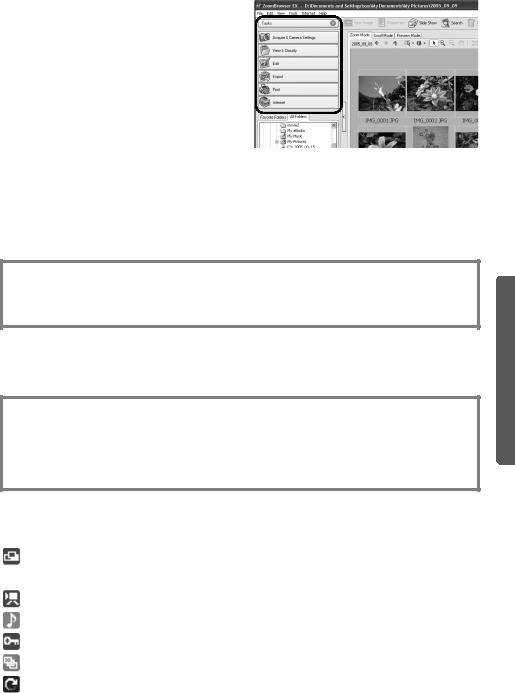
Using the Software on the Windows Platform – Advanced Techniques |
25 |
|
|
Task Area
•ZoomBrowser EX's tasks are arranged here like an index.
•Click a Task button to carry out the desired task.
These features are described in ZoomBrowser EX Features (p. 30)
Folders Area
•Use this area to select folders. The images in the selected folder display in the Browser Area. If you select a network drive in advance with Windows Explorer, you can display network folders, but you cannot add, change or delete those folders in the Browser Area.
•If you selected Favorite Folders, only the folders registered in advance as Favorite Folders will display. You are recommended to register a folder that you use frequently as one of the Favorite Folders. If you selected All Folders, all the folders will display.
Methods for Registering a Favorite Folder
•If [Favorite Folders] is displayed: click [Add] and select a folder.
•If [All Folders] is displayed: select a folder and click [Add to Favorites].
•To delete a folder in the Favorite Folders area, select a folder and click the [Delete] button.
Browser Area
•The images in the folder selected in the Folders Area will display here. The display style will vary according to your Display Mode selection.
Methods for Selecting Images in the Browser Area
•Selecting a single image: click on an image.
•Selecting multiple images: click on the first image and then hold the [Ctrl] key down while clicking on additional images.
•Selecting consecutive images: click on the first image and then hold the [Shift] key down while clicking on the last image.
•You can sort the image order in the Browser Area by file name, shooting date or other characteristics by clicking the [Tools] menu and selecting [View] and [Sort by].
•The following icons will display around images according to their attributes.
Images shot with the camera's Stitch Assist mode
 RAW images
RAW images
Movies
Images with sound memo attachments
Protected images
Images shot with the camera's AEB function
Images shot with the camera on end that are rotated in the display only
Windows
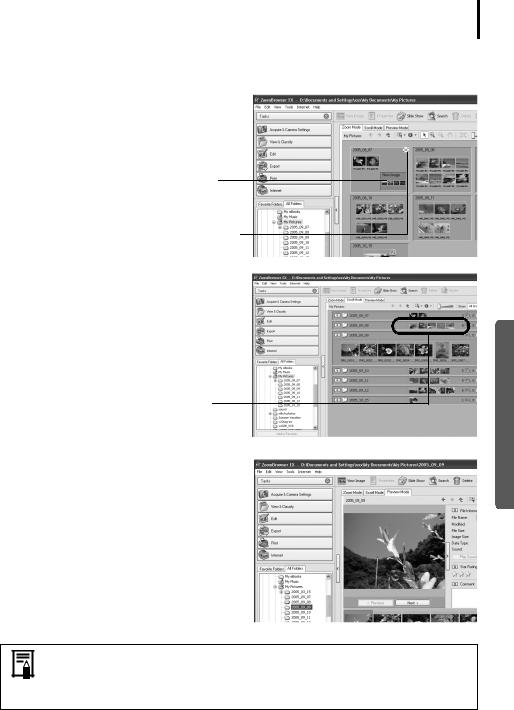
Using the Software on the Windows Platform – Advanced Techniques
Display Mode
•Selects the display style for the Browser Area.
Zoom Mode
Displays all the images in a folder as thumbnail images. This mode is convenient for searching for images since many can be displayed at once.
If additional folders are nested within a folder, their images are displayed as thumbnails as well.
If you move the mouse cursor over a folder,  will display on the upper right. Clicking
will display on the upper right. Clicking
here displays that folder zoomed in.
Scroll Mode
This mode is convenient for checking the images in multiple folders at once. If the displayed folder is at the highest level, then all thumbnails in the lower-level folders also display. You can change the folder level (folder depth) by clicking the [Tools] menu and selecting [Preferences].
The images within nested folders also display.
Preview Mode
This mode displays the image at a larger size as well as the image information.
26
Windows
Positioning the mouse pointer over a thumbnail causes the image to appear at a higher magnification in a Mouse Over Window. You can turn off this function by clicking the  [Show Information], and removing the check mark from the [Show Mouse Over Windows] option.
[Show Information], and removing the check mark from the [Show Mouse Over Windows] option.
